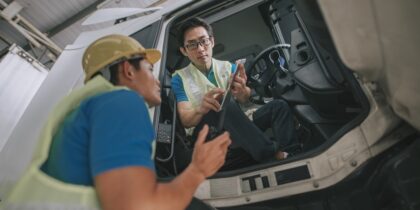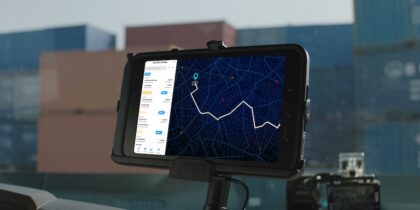As supply chains continue to go digital and AI-enhanced machinery boosts production, frontline workers in most warehouses still rely on outdated technology and, therefore, outdated data.
Mobile technology brings people into the digital age, helping them work smarter and faster. And not a second too soon. With production demands rising and the manufacturing skills gap widening, the industry, as of this writing, has 851,000 open positions in the U.S. and is expected to face 2.1 million unfilled jobs by 2030, according to Deloitte and The Manufacturing Institute.
As warehouses increasingly rely on fewer people to move more product, it’s no wonder manufacturing CFOs cited “investing in tech and infrastructure” as their top business priority in 2021. Meanwhile, the industry’s CIOs say they’re focused on improving operational efficiency.
One solution to help stem these headwinds is represented by rugged mobile devices with cloud-based software. Warehouse workers can use these solutions to access real-time data and communicate with each other on the go. Not only can they complete many different tasks from a single mobile device, but thanks to accessories like innovative mounts and cases, these devices are more durable than ever and easier to use comfortably on the warehouse floor.
Why are rugged tablets and smartphones ideal for the manufacturing industry? And how can warehouse operators deploy mobile solutions that are effective at keeping their teams connected and productive?
Tough enough for factory floors
Not all consumer-grade mobile devices are suitable for warehouse work. But Samsung Galaxy rugged devices can withstand drops on hard concrete floors; they won’t shatter if they’re dropped from a forklift; and their battery lasts all day.
Samsung’s Galaxy XCover6 Pro smartphone and Galaxy Tab Active4 Pro tablet are both built to the Defense Department’s latest MIL-STD-810 specifications. In other words, the Department of Defense (DOD) has certified that these devices can be dropped repeatedly without breaking, function at extreme temperatures and high humidity and are resistant to water, dust and shock.
These Galaxy devices have powerful batteries that support fast wireless charging and feature a power-saving mode to extend their life. The same devices also feature heavy-duty pogo pin connectors that make it easy for warehouse workers to pop their device into a charging bay or ProClip Mount as needed, or attach accessories from the OtterBox uniVERSE.
5 ways to mobilize your warehouse
The benefits of rugged devices in the warehouse are well established. So how can warehouse operators get the most out of their mobile deployment?
1. Get devices in the hands of every employee
Frontline workers waste precious time when they have to rely on shared devices to access information and communicate across departments. With a protected, rugged mobile device in every person’s hands, they have continuous access to the data they need to work most efficiently.
Of course, for these devices to be helpful, they need to be charged and accessible at all times. That’s easier than ever thanks to charging accessories like the ProClip 4-Bay Tabletop Charging Station, designed to charge Samsung devices and work seamlessly with the OtterBox uniVERSE case system.
2. Streamline scanning with mobile
Single-use tools like handheld scanners are longtime warehouse staples. But with the right mobile solution, workers can scan barcodes using the same rugged smartphone or tablet they use for everything else.
Samsung’s line of rugged mobile devices features Knox Capture, which enables enterprise-grade scanning from a consumer-grade device. Powered by Scandit’s award-winning data capture engine, Knox Capture integrates with inventory management systems and activates special camera features designed for frontline use. Rocky Rickard, Head of Manufacturing Business Development for Samsung had this to add on the usage of Knox Capture: “Knox Capture is ideal for customers wanting to move to smartphones for their scanning needs while maintaining status quo with their apps and workflows.”
3. Forklift operators have easy access to real-time information
Forklift operators keep things moving — in every sense. Leafing through printed order lists and answering walkie-talkie calls with pickup requests slows them down, which bottlenecks everyone down the line of operations.
Rugged tablets, integrated with the appropriate software, keep drivers on the move, telling them where to go and what to pick up next — based on real-time data, not outdated printouts. With ProClip Tablet Mounts and OtterBox uniVERSE cases, forklift tablets can be optimally positioned — easily accessible but out of the driver’s line of sight, to maintain a safe workflow. And if the forklift operator needs to travel on foot, they can simply pop the tablet out of the mount and take it with them.
4. Enhance communications with mobile push-to-talk (PTT)
Like barcode scanners, handheld radios are another single-purpose device frontline workers need to carry and charge. But with a few modifications, the right smartphone can deliver that familiar PTT experience, as well as a variety of additional communication channels — on an all-in-one device.
Galaxy XCover6 Pro, for example, features a programmable button that enables PTT conversations without needing to unlock the device or dial a number. And if the warehouse is too noisy for voice communications, the same device can be used to text a colleague or group message the whole team.
The definitive guide to warehouse efficiency
Get your free guide to increasing warehouse efficiencies and cutting costs with mobile processes. Download Now
Thanks to the OtterBox uniVERSE case system, workers can strap their mobile device to their hip like a traditional radio, for even easier access to the programmable PTT button.
5. Extend mobile to the desktop
Warehouse workers are usually on the move, and a mobile computing device can move with them. But some tasks are still easier with a full-size monitor, keyboard and mouse.
Galaxy Tab Active4 Pro is equipped with Samsung DeX to provide a desktop experience without the computer. Workers simply slip their mobile device into a docking station (such as the ProClip XL Table Stand) and their on-screen content moves to the full-size monitor. “Today’s powerful smartphones are set to replace the traditional PC for many professionals, introducing a new era of “mobile-only” computing. Samsung’s DeX platform can allow your organization to go mobile-only today, leveraging Samsung smartphones and tablets to drive both on-the-go and desktop computing capabilities,” Rocky added.
Looping frontline workers into Industry 4.0
Equipping warehouse workers with mobile solutions can streamline operations to make them more efficient. Mobile puts frontline workers at the edge of innovation, empowering them to take part in Industry 4.0 as you redesign the supply chain of the future.
Discover how Galaxy Tab Active4 Pro can upgrade your frontline operations, big and small. Or find which Samsung tablet would best support your business needs with this quick free assessment.








